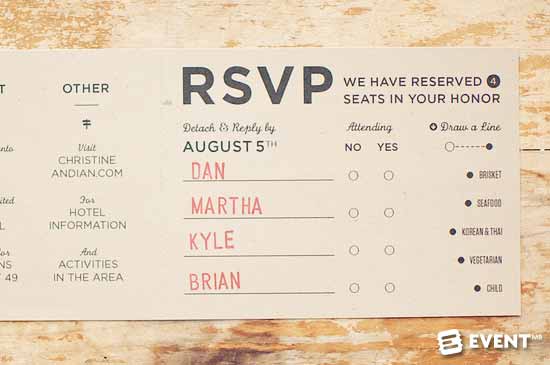Skift Take
Event invitations offer so many options nowadays. From traditional paper invitations, to digital evites, it is hard to know which is right for your event. We get the lowdown on modern day invitations and etiquette.
While the format may have changed, invitations themselves are still just as relevant today as they were. They are often the first point of contact to your guests and can set the tone for the event and build excitement long before the day arrives.
Invitations no longer have to be sent formally by mail, they are now easily issued and accepted via social media and email, for quick and easy responses. That being said, your choice of invitation should suit your event and reflect the formality you are going for. An evite may not be the preferred option for black tie dinners or fundraisers but likewise there is no need to go all out with paper invitations for a conference or small social event.
What To Include
An invitation, particularly for a social occasion, will often include this key information:
- Attendee invited
- Name of hosts – personal as well as company or organisation overseeing the event
- The event type – fundraiser, ball etc
- Day, date and time of the event
- Name of the location and the address. The zip code is not usually necessary in the US but postcodes are recommended in the UK.
- Dress code
- RSVP or response guidelines
- Additional information: e.g. parking arrangements, children allowed, plus one, special requests/dietary, dining options, end times
The History Of Invitations
Written
Traditionally, invitations were used for social events by aristocrats in high society and created a sense of exclusivity by only extending invitations to those who were “worthy”. It was considered an honour just to receive an invitation and great care was given when creating them using calligraphy and wax seals.
Printed
Commercially printed invitations increased in the US after World War One several centuries after the introduction of the printing press, but this level of technology was still only reserved for the wealthy or elite because it was very expensive. Today printing via a professional print house is quick, easy and affordable and lots of stunning designs and effects can be created. Even colour printers within offices nowadays can print to a high standard.
Electronic
Nowadays with the introduction of technology and the ease of communication, invitations are often sent electronically, via email or social media or even via an event app. Evites break the rules and don’t follow the formal invitation etiquette of the past.
The Double Envelope
Even today, you may wonder why formal invitations commonly have two envelopes, one inside the other and this is because historically when they were handwritten for larger households they would be delivered by hand (usually by a footman) to a house with extended family or other guests. The household address would go on the outer envelope so it would get to the correct place and then once there, the family would open and find the envelope to the recipient(s) inside (as not everyone was always invited).
Paper Vs Electronic/Digital Invitations
Traditional Paper Invitations
Pros
- Paper invites are more formal, cost money and require time and effort to set up which although can be a con in itself, it means they are taken more seriously by guests and as a result means your RSVP rate is naturally higher than with digital invitations. It is also a constant reminder to those invited, unlike emails which are easily buried and forgotten.
- Traditional invitations are tangible, which can mean they are more memorable and create a sense of exclusivity. It isn’t something that is received “every day” and is therefore quite a novelty.
- As they are addressed to someone specifically, it is clear who is invited and sets better boundaries surrounding the event rather than an email that could be forwarded on or extended to a wider circle of people.
- It is guaranteed to get there, especially if you pay for tracked postage so there is no mistake about people not getting the invite.
- In this world of social media, ironically sending traditional invitations probably means many guests will share the invitation with their social networks to ‘brag’.
Cons
- With design, printing and postage this is the most expensive option. Bespoke designs using special paper, embossing, unusual sizes and paper cut outs can all increase the cost greatly.
- Unlike with emails, an attendee cannot simply recall the invite if they lose it which means they lose all the information and details as well and means they have no back-up option other than to call the organizers and get a new copy or details sent out.
Electronic Invitations
Pros
- Emails and digital invites are usually free to send if you send via email or one of the free email marketing platforms. A lot of event registration sites enable you to send evites directly from the system to keep everything consistent.
- Some tools allow you to create a professional design in line with your event branding, without any design experience. Alternatively you can still pay a designer to create something impactful which will be uploaded and sent out electronically.
- Digital invitations are great for public events where there are no limits to the attendees and you are trying to encourage sign up from a large amount of people. It makes it easy for people to forward details to their networks if it is an open invitation to a public event.
- Unnecessary printing is frowned upon and evites are definitely the most eco-friendly option for sustainability conscious guests.
- You can include a lot more information in an evite than an actual invitation, as well as adding more sponsorship and advertising spots, which can be tracked.
- You can create interesting effects and have moving graphics on screen that aren’t possible with paper invitations (yet).
Cons
- Some guests may not have or check their email regularly and depending on your demographics you may find not everyone is email accessible. Spam filters can often block emails, particularly with graphics or if sent out to a mass email list, and this can cause a lot of perceived non-attendance, when they actually just didn’t get the invite.
- If you need guests to take their invitation along to the event or to pre-print their badge, make it clear whether it is fine to show the invitation on mobile. Printing can be difficult and requires attendees to remember to do it and bring it along and some may not have the facilities.
- May not be suitable for formal, high profile or significant events, unless they are just serving as a reminder, because it can come across as cheap. At high class fundraisers in particular, you can’t expect people to raise a lot of money if you send out cheap invites.
- Evites can easily be missed in the swarm of emails that people get on a day to day basis and are easily pushed down the inbox and forgotten, especially when sending to business email addresses.
- An attendee may see the email and then go to respond to it at a later date and ‘lose it’ in their inbox meaning they can’t actually respond if they don’t know what to search for.
- As they are perceived as less formal and in some cases carry less of an impact you get a much lower RSVP rate, even if that is the action you are requesting.
Are Traditional or Digital Invitations Best for Your Event
Paper invitations are still a good choice for exclusive or formal events, particularly social occasions. For less formal events you may not be able to decide between paper or electronic. These questions may help you decide which fits best.
Send Paper?
- Is it a once in a lifetime or exclusive event such as a wedding, awards ceremony or movie premiere?
- Is the event over a month away?
- Do you need more than a Yes/No RSVP?
- Are 30% (or more) of the guests not accessible by email?
Send Electronic?
- Is the event soon (less than a month)?
- Is it a regular event, e.g. a networking event or annual company retreat?
- Can you access over 80% of the guests via email?
- Is it for a professional audience?
- Does it require an RSVP at all and if so is it via an online registration process?
If you have answered yes to most or all of one category you should have your answer.
Invitation Etiquette
Responding
RSVP
This stands for Respondez, S’il Vous Plait, so if an attendee sees this on an invitation then a response is required. Correct etiquette is that guests should aim to RSVP within 2-3 days of receiving the invitation but this requirement to take action is being eroded unfortunately and many event planners choose to add a clear deadline that means if you have not RSVP’d by then you will be removed from the list. This is primarily because some events are seated or catered and therefore knowing the numbers attending is essential.
For event planners you should always include the RSVP details including who to contact and how, or add an RSVP note to send back.
Regrets Only
This means you should only reply if you cannot attend and details of who to contact and how to reach them should be included. Do not add RSVP and Regrets only as this sends a mixed message.
Not Showing Up
Event planning takes time and effort and non-attendance is one of the biggest frustrations for event planners. if a guest has received an invitation then replying is the proper etiquette whether you are interested in the event or not but unfortunately this courtesy is being forgotten. As a penalty for not attending some eventprofs drop serial offenders from the guest lists for future events or charge a non-attendance fee.
Changing Your Mind
It is usually unacceptable to change your mind after RSVP’ing, except in cases of illness and family emergency, where you should try to give the host as much notice as possible. For event planners it is better to put a number or email on the RSVP for any last minute changes as well as a return address etc. so you can easily be contacted if guests change their mind.
Guests suddenly deciding that they are coming at the last minute can also cause problems for the host who may have already decided on the table plan. Last-minute attendees should give as much notice as possible and be prepared that there might not be a space for them.
Plus One
Guests should always indicate whether or not they will be bringing a plus one on the RSVP if the invite extends them this option, and if possible their name. Attendees should never bring a plus one if they weren’t invited and the more notice and information about your guest that the host receives, the better accommodated they both will be.
Children
Generally, unless it specifically addresses children or states “children welcome” on an invitation, kids are not invited.
Advance Notice
Invitations aim to give your guests as much notice of your upcoming event as possible to maximize the chances of people being able to attend. It is important to give guests enough warning but if you tell them too soon they could forget, especially if the date is months in advance and you offer no reminders, therefore if you are going to send invitations out very early you should always send a follow up nearer the time.
For weddings a save the date invitation will be sent a number of months in advance with a full invitation and details arriving at least 4 to 8 weeks before the day with an RSVP to organize a head count.
For other events invitations can be sent out commonly around 4 weeks before the event start although public events and fee-paying events will be marketing and promoting long before this. Corporate events will be looking to open registrations at least 2-3 months or more in advance.
Timings differ not only depending on the type of event but also according to the country. Apparently the US typically sends out event invitations with a longer lead time than event planners have in the UK.
Avoid Digital Mass Sending
As paperless invitations tend to be free it can be tempting to expand your list and send out to others for a wider reach. This may not necessarily yield results and as you tend to get a lower response rate for digital invitations it may not work at all and could blacklist you as a spammer and give a negative reaction to your brand.
In Conclusion
Invitations are just as important now as they have ever been, but the methods to send them and the etiquette to respond to them has changed drastically. Invitations are now so accessible eventprofs need to be careful to retain exclusivity and chose the right invitation to suit the event, as this has a direct impact in terms of the response rate.










